Case Study: Mill vs Gradle
This page goes into the weeds comparing the Mill and Gradle build tools. For a higher-level comparison of Mill vs other tools, and why Mill is interesting, see the page Why Use Mill?.
Compared to Gradle, Mill tries to improve in the following ways:
-
Performance: Mill compiles the same project 3-4x faster than Gradle. Mill is generally much more aggressive at caching and parallelizing things than Gradle is, and tries hard to minimize the overhead the build tool adds on top of the build logic being executed
-
Extensibility: Mill makes customizing the build tool much easier than Gradle. When defining custom tasks, you do not need to worry about registering task dependencies, registering tasks, assigning output folders on disk, and so on. You just write your build step as a normal method
defthat calls other methods, and all that boilerplate work is done automatically for you. -
IDE Support: Mill has better IDE support in tools like IntelliJ or VsCode than Gradle does. Whether using the Groovy syntax or the Kotlin syntax, jump-to-definition in Gradle would frequently bring you to stub getter-setter methods or de-compiled classfiles (or both at the same time!). With Mill, IntelliJ is able to navigate around the build logic just as easil as any application codebase, making it easier to navigate, understand, and maintain your build configuration.
This page compares using Mill to Gradle using the Mockito Testing Library codebase as the example. Mockito is a medium sized codebase, 100,000 lines of Java split over 22 subprojects. By porting it to Mill, this case study should give you an idea of how Mill compares to Gradle in more realistic, real-world projects.
To do this, we have written a Mill build.mill file for the Mockito project. This can be used
with Mill to build and test the various submodules of the Mockito project without needing to
change any other files in the repository:
Completeness
The Mill build for Mockito is not 100% complete, but it covers most of the major parts of Mockito: compiling Java, running JUnit tests. For now, the Android, Kotlin, and OSGI tests are skipped, as support for Building Android apps in Mill and Kotlin with Mill is still experimental.
The goal of this exercise is not to be 100% feature complete enough to replace the Gradle build today. It is instead meant to provide a realistic comparison of how using Mill in a realistic, real-world project compares to using Gradle.
Performance
The Mill build for Mockito is generally snappier than the Gradle build. This applies to most workflows, but the difference matters most for workflows which are short-lived, where the difference in the fixed overhead of the build tool is most noticeable.
For comparison purposes, I disabled the Gradle subprojects that we did not fully implement in Mill
(groovyTest, groovyInlineTest, kotlinTest, kotlinReleaseCoroutinesTest, android,
osgi-test, java21-test), and added the necessary flags to ensure caching/parallelism/etc. is
configured similarly for both tools. This ensures the comparison is fair with both builds compiling the
same code and running the same tests in the same way.
For the benchmarks below, each provided number is the median wall time of three consecutive runs
on my M1 Macbook Pro with Java 17 and Mill 0.12.9-native. While ad-hoc, these benchmarks are
enough to give you a flavor of how Mill’s performance compares to Gradle:
| Benchmark | Gradle | Mill | Speedup |
|---|---|---|---|
17.6s |
5.86s |
3.0x |
|
12.3s |
3.75s |
3.3x |
|
4.41s |
1.30s |
3.4x |
|
1.37s |
0.20s |
6.9x |
|
0.94s |
0.11s |
8.5x |
The column on the right shows the speedups of how much faster Mill is compared to the equivalent Gradle workflow. In most cases, Mill is 2-4x faster than Gradle. Below, we will go into more detail of each benchmark: how they were run, what they mean, and how we can explain the difference in performing the same task with the two different build tools.
Sequential Clean Compile All
$ ./gradlew clean; time ./gradlew classes testClasses --no-build-cache
17.6s
18.2s
17.4s
$ ./mill clean; time ./mill -j 1 __.compile
6.19s
5.86s
5.28sThis benchmark measures the time taken to sequentially compiled all the Java code in the Mockito code base. The goal of this benchmark is to try and measure the "clean compile everything" step, without the effects of parallelism that can be nondeterministic and vary wildly from machine to machine depending on the number of cores available.
To limit our comparison to compiling Java code only, we avoid
using build in favor of classes and testClasses: this skips running tests,
lint, jar/docjar generation, and other steps that build performs to make it an apples-to-apples
comparison. Furthermore, Gradle parallelizes the build by default and caches things globally
under ~/.gradle/caches, while Mill parallelizes by default but does not cache things globally.
Again to make it a fair comparison, we use --no-build-cache in Gradle and set
org.gradle.parallel=false in gradle.properties, and pass -j 1 to limit Mill to a
single thread.
Here we see Mill being about ~3.3x faster than Gradle, to do the equivalent amount of work. As a point of reference, Java typically compiles at 10,000-50,000 lines per second on a single thread, and the Mockito codebase is ~100,000 lines of code, so we would expect compile to take 2-10 seconds without parallelism. The 5-6s taken by Mill seems about what you would expect for a codebase of this size, and the ~17s taken by Gradle is much more than what you would expect from simple Java compilation.
It’s actually not clear to me where the difference in execution time is coming from. Unlike the Mill v.s. Maven comparison, Gradle’s command line output doesn’t show any obvious network requests or jar packing/unpacking/comparing going on. But Gradle’s CLI output is also much less verbose than Maven’s, so it’s possible things are going on under the hood that I’m not aware of.
Parallel Clean Compile All
$ ./gradlew clean; time ./gradlew classes testClasses --no-build-cache
13.8s
12.3s
11.4s
$ ./mill clean; time ./mill __.compile
3.75s
3.74s
3.86sThis benchmark is identical to the Sequential Clean Compile All benchmark above, but enables
parallelism: Gradle by default, Mill without -j 1 to run on 10 cores (the number on my Macbook Pro).
Neither Gradle nor Mill benefit hugely from parallelism: both show a moderate ~50% speedup, despite receiving 900% more CPUs. This likely indicates that the module dependency graph of the Mockito codebase is laid out in a way that does not allow huge amounts of compile-time parallelism.
Again, we see Mill being about ~3.4x faster than Gradle, to do the equivalent amount of work. This indicates the the speedup Mill provides over Gradle is unrelated to the parallelism of each tool.
Clean Compile Single-Module
$ ./gradlew clean; time ./gradlew :classes --no-build-cache
4.14s
4.41s
4.41s
$ ./mill clean; time ./mill compile
1.30s
1.90s
1.13sThis benchmark indicates the use case of clean-compiling a single module. In this case,
the root module in src/main/java/ containing the bulk of the Mockito library code,
excluding the test code in src/test/java/ and all the downstream subprojects in
subprojects/.
This benchmark gives us Mill being about ~3.7x faster than Gradle. This is in line with the results above.
Incremental Compile Single-Module
$ echo "" >> src/main/java/org/mockito/BDDMockito.java; time ./gradlew :classes
1.37s
1.39s
1.28s
$ echo "" >> src/main/java/org/mockito/BDDMockito.java; time ./mill compile
compiling 1 Java source to /Users/lihaoyi/Github/netty/out/common/compile.dest/classes ...
0.23s
0.20s
0.20sThis benchmark measures the common case of making a tiny change to a single file and
re-compiling just that module. This is the common workflow that most software developers
do over and over day-in and day-out. We simulate this by appending a new line to the
file src/main/java/org/mockito/BDDMockito.java.
Both Mill and Gradle are able to take advantage of the small code change and re-compile only the single files needing re-compilation, demonstrating substantial speedups over the Clean Compile Single-Module benchmark above. Mill remains faster than Gradle, showing a ~2.7x speedup for this task
No-Op Compile Single-Module
$ time ./gradlew :classes
0.95s
0.93s
0.94s
$ time ./mill compile
0.13s
0.11s
0.10sThis benchmark is meant to measure the pure overhead of running the build tool: given a single module that did not change, the build tool should need to do nothing in response, and so any time taken is pure overhead.
For both Mill and Gradle, we see small speedups relative to the Incremental Compile Single-Module benchmark above, which likely comes from not having to compile any Java source files at all. Mill remains faster than Gradle by about 2.0x.
Extensibility
Another facet of Mill is that is worth exploring is the ease of making custom tasks or build steps. For example, in Mill, overriding the resources to duplicate a file can be done as follows:
def resources = Task {
os.copy(
compile().classes.path / "org/mockito/internal/creation/bytebuddy/inject/MockMethodDispatcher.class",
Task.dest / "org/mockito/internal/creation/bytebuddy/inject/MockMethodDispatcher.raw",
createFolders = true
)
super.resources() ++ Seq(PathRef(Task.dest))
}In Gradle, it is written as:
tasks.register('copyMockMethodDispatcher', Copy) {
dependsOn compileJava
from "${sourceSets.main.java.classesDirectory.get()}/org/mockito/internal/creation/bytebuddy/inject/MockMethodDispatcher.class"
into layout.buildDirectory.dir("generated/resources/inline/org/mockito/internal/creation/bytebuddy/inject")
rename '(.+)\\.class', '$1.raw'
}
classes.dependsOn("copyMockMethodDispatcher")
sourceSets.main {
resources {
output.dir(layout.buildDirectory.dir("generated/resources/inline"))
}
}At a first glance, both of these snippets do the same thing, just with different syntaxes and helper method names. However, on a deeper look, a few things are worth noting:
-
In Mill, you do not need to manually add
dependsOnclauses, unlike Gradle:-
In Mill, referencing the value of
compile(), we both explicitly get access to the value ofcompileand also add a dependency on it. In Gradle, you need to separately adddependsOn compileto mark the dependency, andrename '(.+)\\.class', '$1.raw'to make use of it implicitly. -
In Mill, overriding
def resourcesis enough to make all tasks that previously depended onresourcesnow depend on the override (e.g.run,test,jar,assembly, etc.) as is the norm for object-orientedoverrides. In Gradle, you need to explicitly callclasses.dependsOn("copyMockMethodDispatcher")to make the downstreamclassestask depend oncopyMockMethodDispatcher, andsourcesSets.main resources output.dirto wire up the generated files to the resources of the module
-
-
In Mill, the
resourcestask is given a uniqueTask.destfolder that is unique to it. In contrast, Gradle’scopyMockMethodDispatcherputs things in a globalgenerated/folder-
This means that in Mill, you do not need to worry about filesystem collisions, since every task’s
Task.destis unique. In contrast, in Gradle you need to make sure that no other task in the entire build is scribbling overgenerated/, otherwise they could interfere with one another in confusing ways -
This also means that in Mill, you always know where the output of a particular task is -
foo.bar.resourceswrites toout/foo/bar/resources.dest/- so you can always easily find the output of a particular task. In Gradle, you have to dig through the source code to find where the task is implemented and see where it is writing to.
-
-
Mill passes typed structured
Paths andPathRefs between each other, while Gradle often uses raw path strings-
In Mill,
def resourcesreturns aPathRef(Task.dest)for downstream tasks to use, so downstream tasks can use it directly (similar to how it makes use ofcompile().classes.pathdirectly). This means different tasks can refer to each other in a foolproof way without room for error -
In Gradle,
sourcesSets.map resources output.dirneeds to refer to the path generated bycopyMockMethodDispatchervia it’s string"generated/resources/inline". That adds a lot of room for error, since the strings can easily get out of sync accidentally.
-
In general, although the two snippets aren’t that different superficially, Mill makes it easy to do the right thing by default:
-
Upstream task dependencies are recorded automatically when used
-
Overridden definitions and automatically used by downstream tasks
-
Every task is automatically assigned a place on disk so you don’t need to worry about collisions and can easily find outputs
-
Tasks interact with each other via typed structured values -
Paths,PathRefs, etc. - rather than magic strings
Although in Gradle it is possible for an expert to customize their build in a way that mitigates these issues, Mill does it automatically and in a way that is foolproof even for non-experts. This helps democratize the build so that any engineer can contribute fixes or improvements without needing to be a build-system expert and learn all the best practices first.
Lastly, as mentioned earlier, the Gradle script has limited IDE support: it can autocomplete things for you, but once you try to jump-to-definition or otherwise navigate your build you hit a wall: it tells you some minimal documentation about the identifier, but nothing about how it is implemented or where it is used:
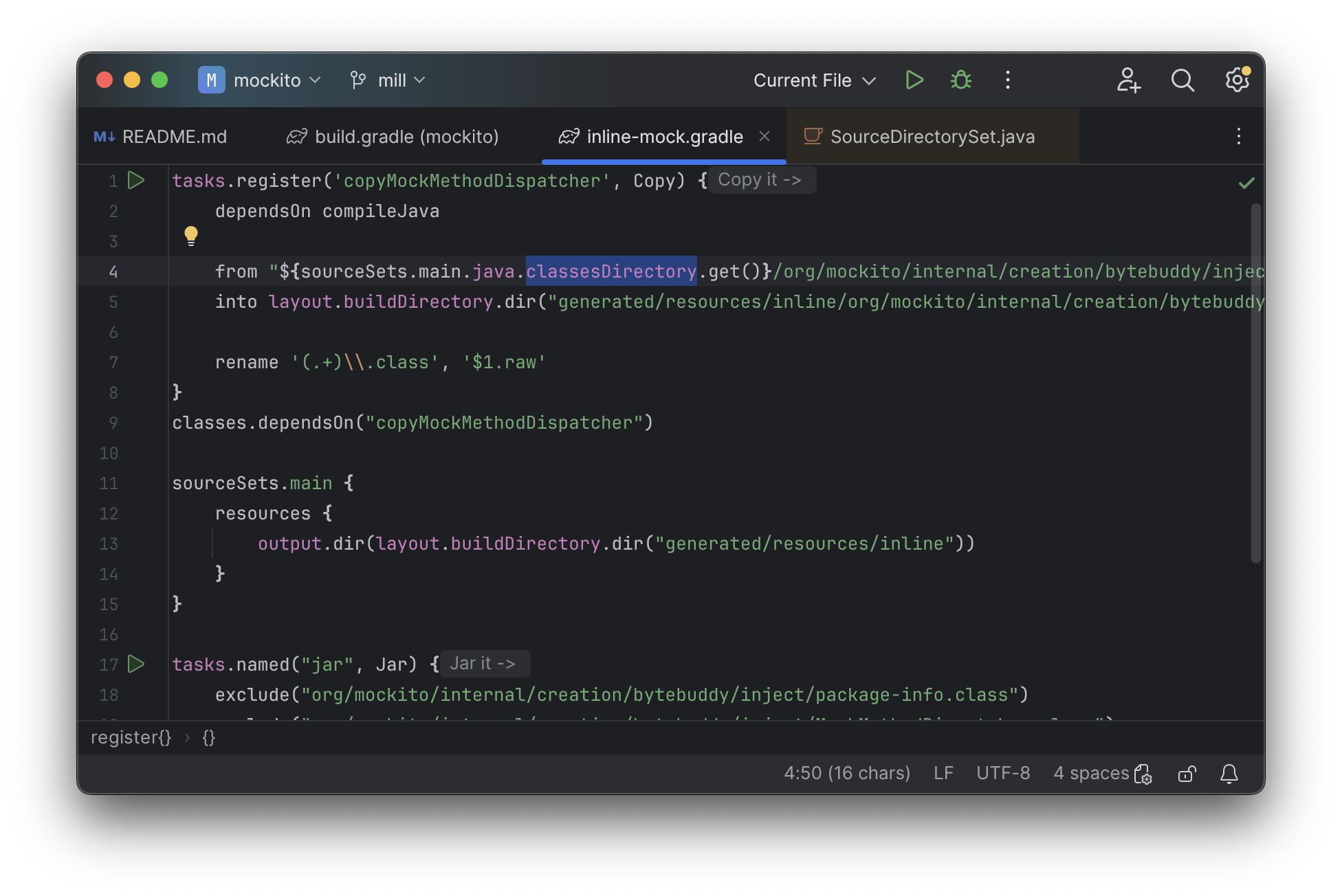

In contrast, IntelliJ is able to navigate straight to the definition of compile() in the
Mill build (as we saw earlier in IDE Experience), and from there can continue to
traverse the build via jump to definition (which we saw earlier) or find usages,
as we saw earlier:
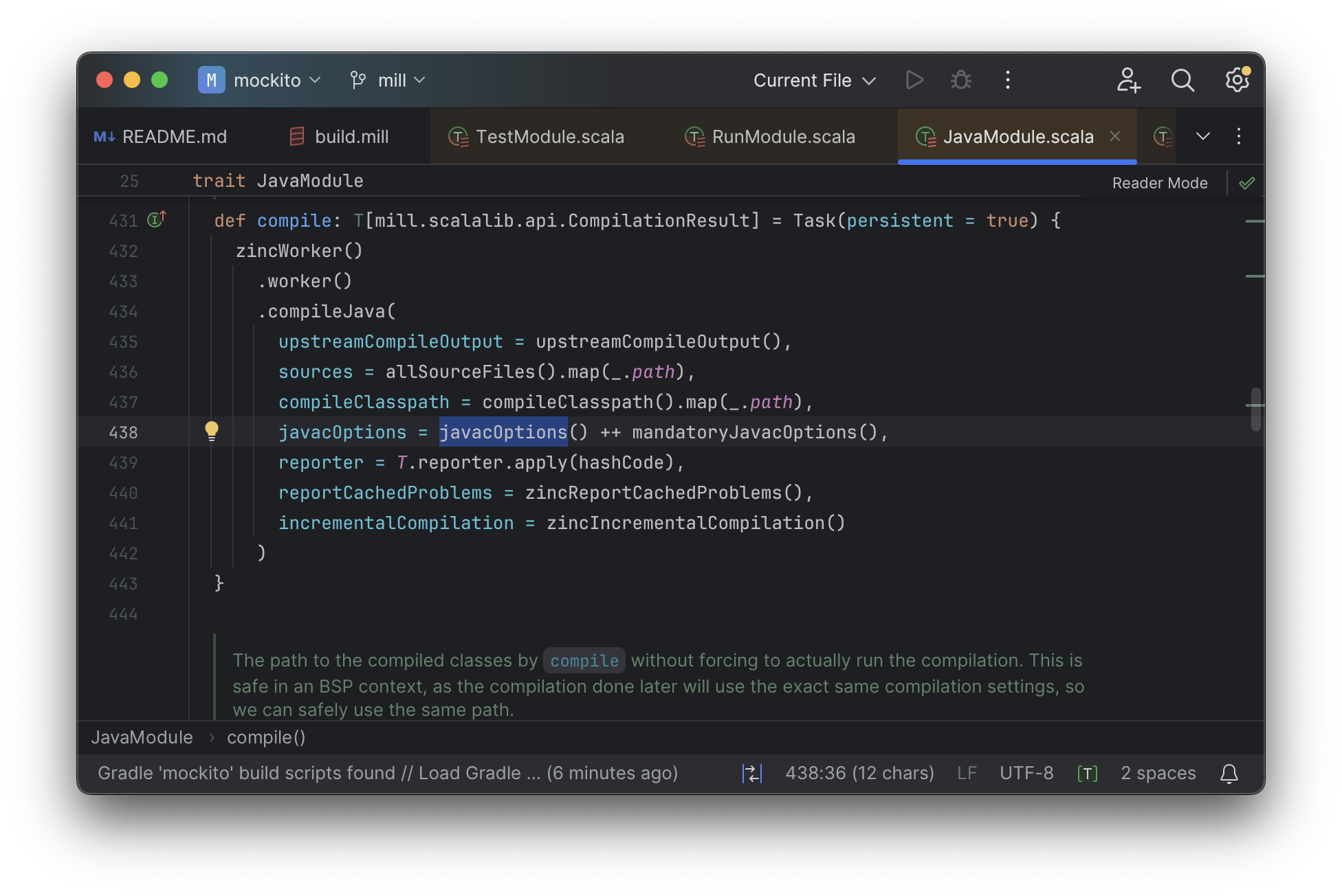
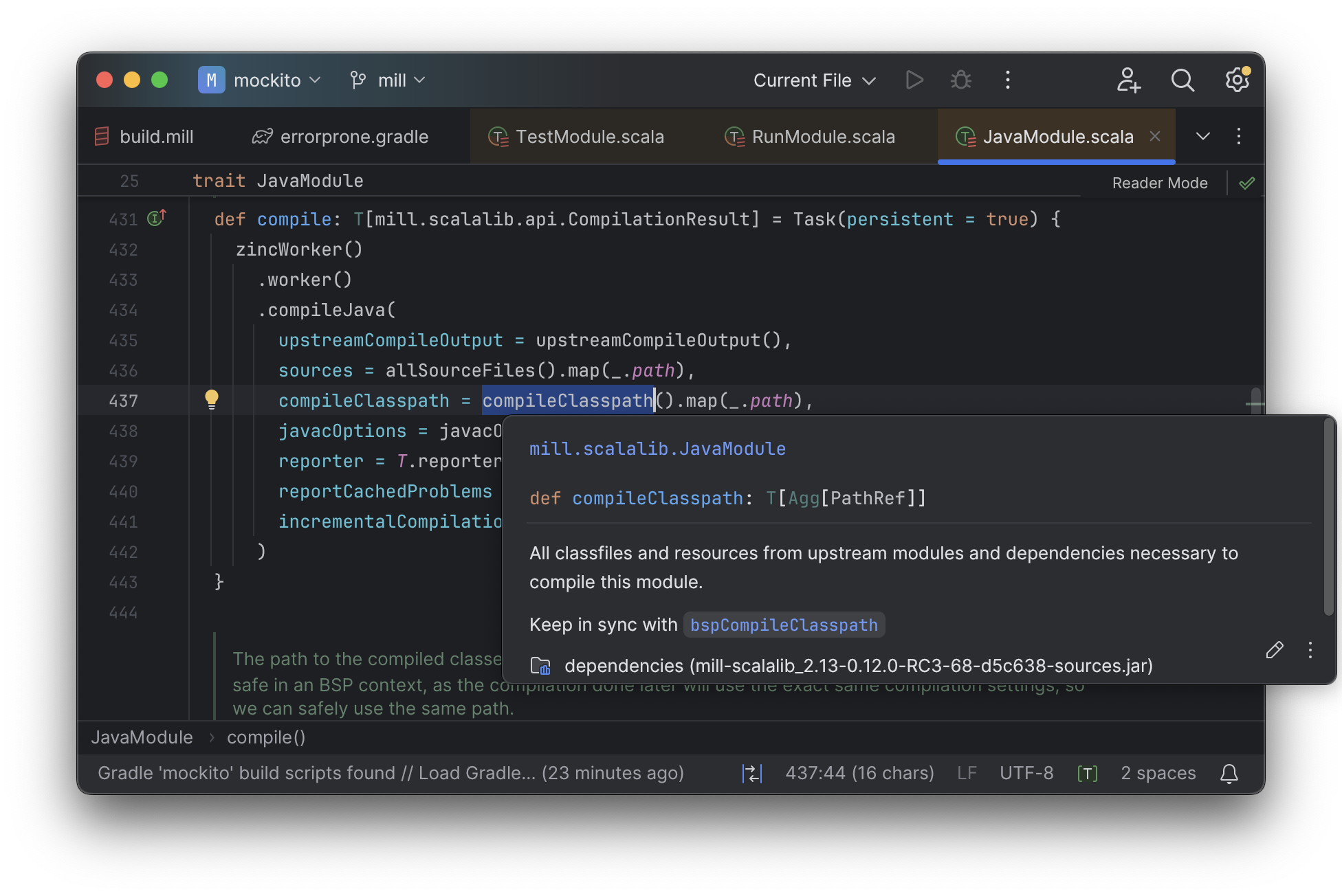
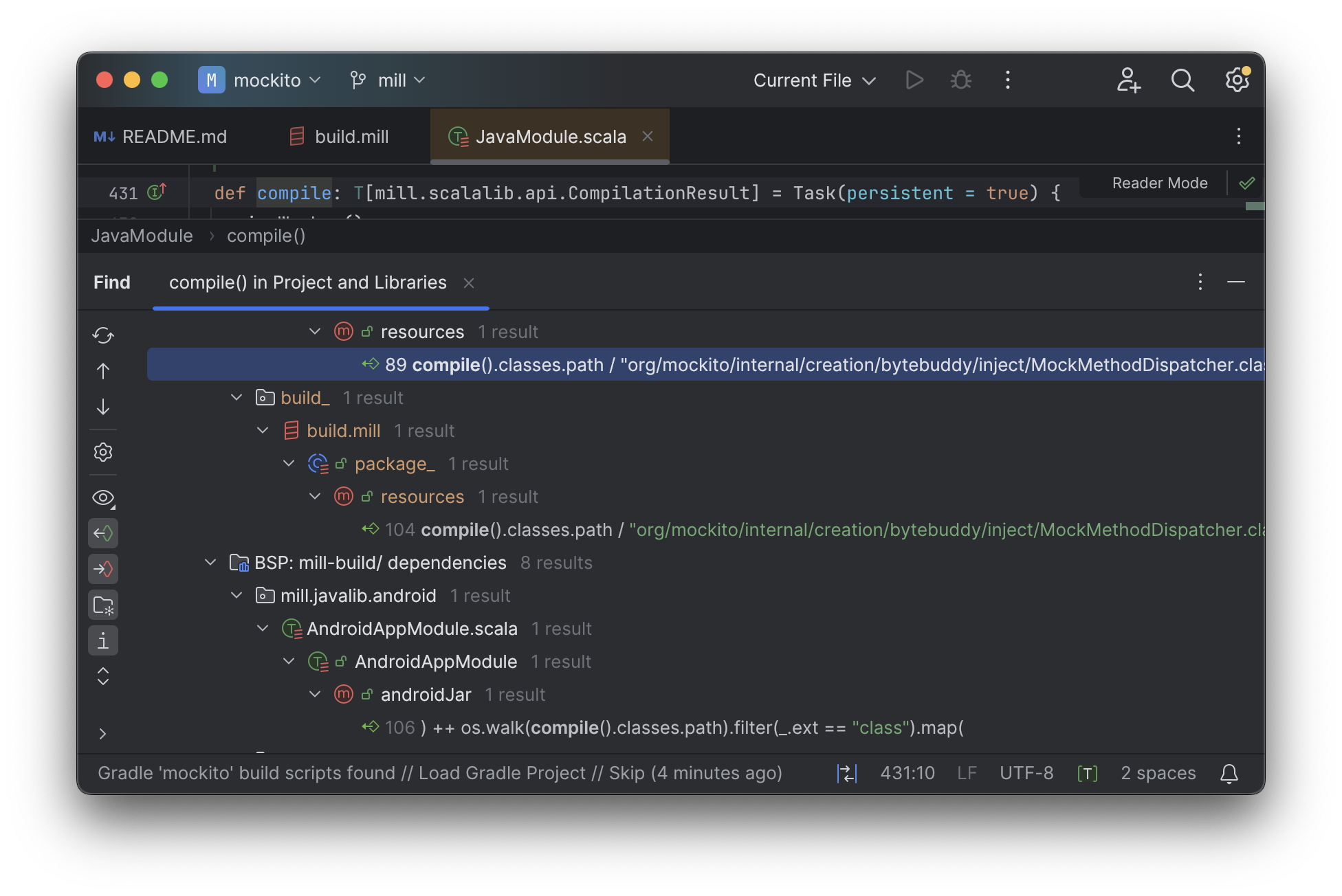
Mill build scripts are written in Scala, but you do not need to be an expert in Scala to use Mill, just like you do not need to be an expert in Groovy to use Gradle. Because Mill has great IDE support, and does the right things by default, I hope it would be much easier for a non-expert to contribute to a Mill build than it would be for a non-expert to contribute to Gradle
IDE Experience
One area that Mill does better than Gradle is providing a seamless IDE experience. For example,
consider the snippet below where we are using Gradle to configure the javac compiler options.
Due to .gradle files being untyped Groovy, the autocomplete and code-assist experience working
with these files is hit-or-miss. In the example below, we can see that IntelliJ is able to identify
that compileArgs exists and has the type List<String>:
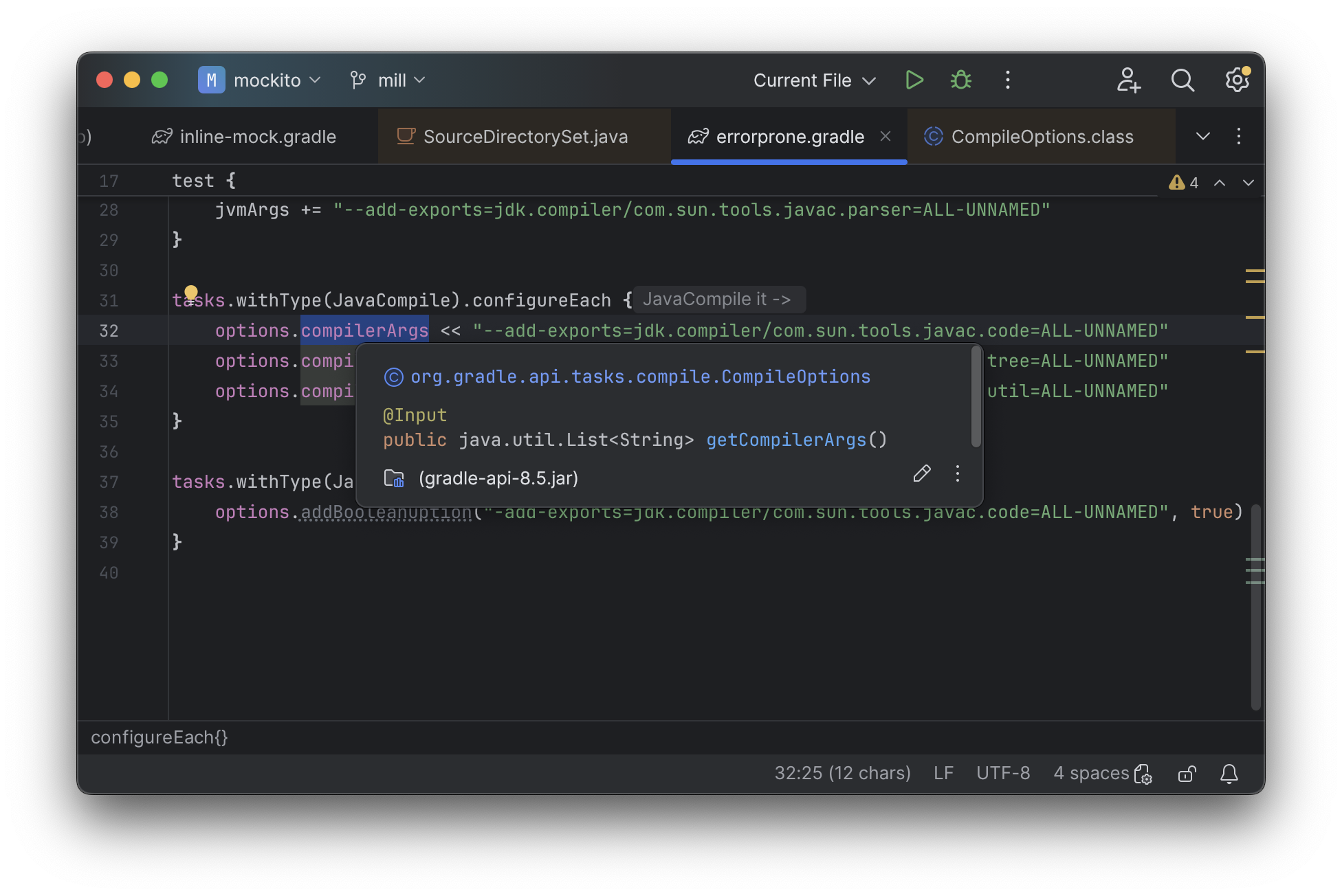
But if you try to jump to definition or find out anything else about it you hit a wall:
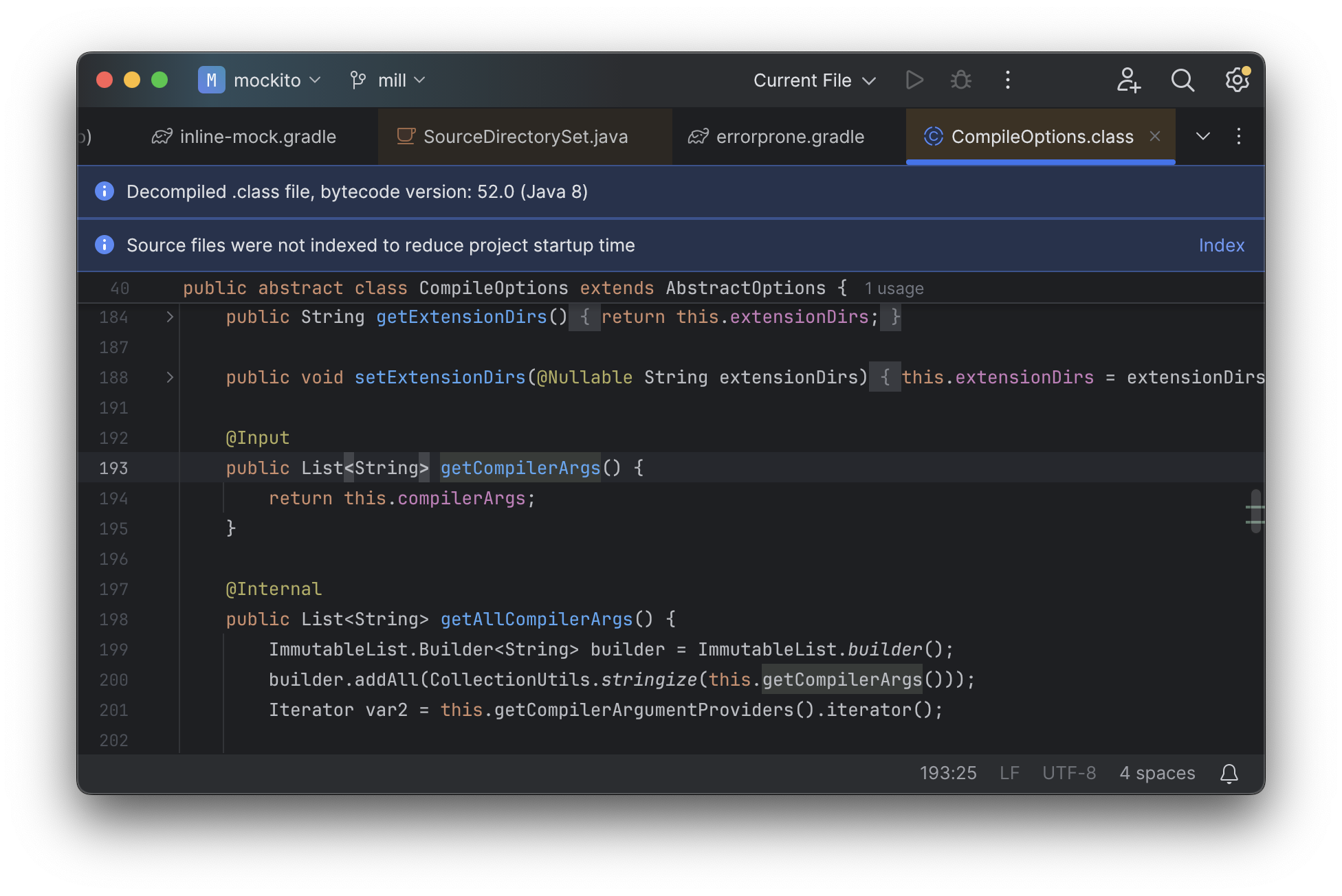
Often working with build configurations feels like hitting dead ends: if you don’t have
options.compilerArgs memorized in your head, there is literally nothing you can do in your editor to
make progress to figure out what it is or what it is used for. That leaves you googling
for answers, which can be a frustrating experience that distracts you from the task at hand.
The fundamental problem with tools like Gradle is that the code you write does not actually perform the build: rather, you are just setting up some data structure that is used to configure the real build engine that runs later. Thus when you explore the Gradle build in an IDE, the IDE can only explore the configuration logic (which is usually un-interesting) and is unable to explore the actual build logic (which is what you actually care about!)
In comparison, Mill’s .mill files are all statically typed, and as a result IntelliJ is easily able to
pull up the documentation for def javacOptions, even though it doesn’t have any special support
for Mill built into the IDE:
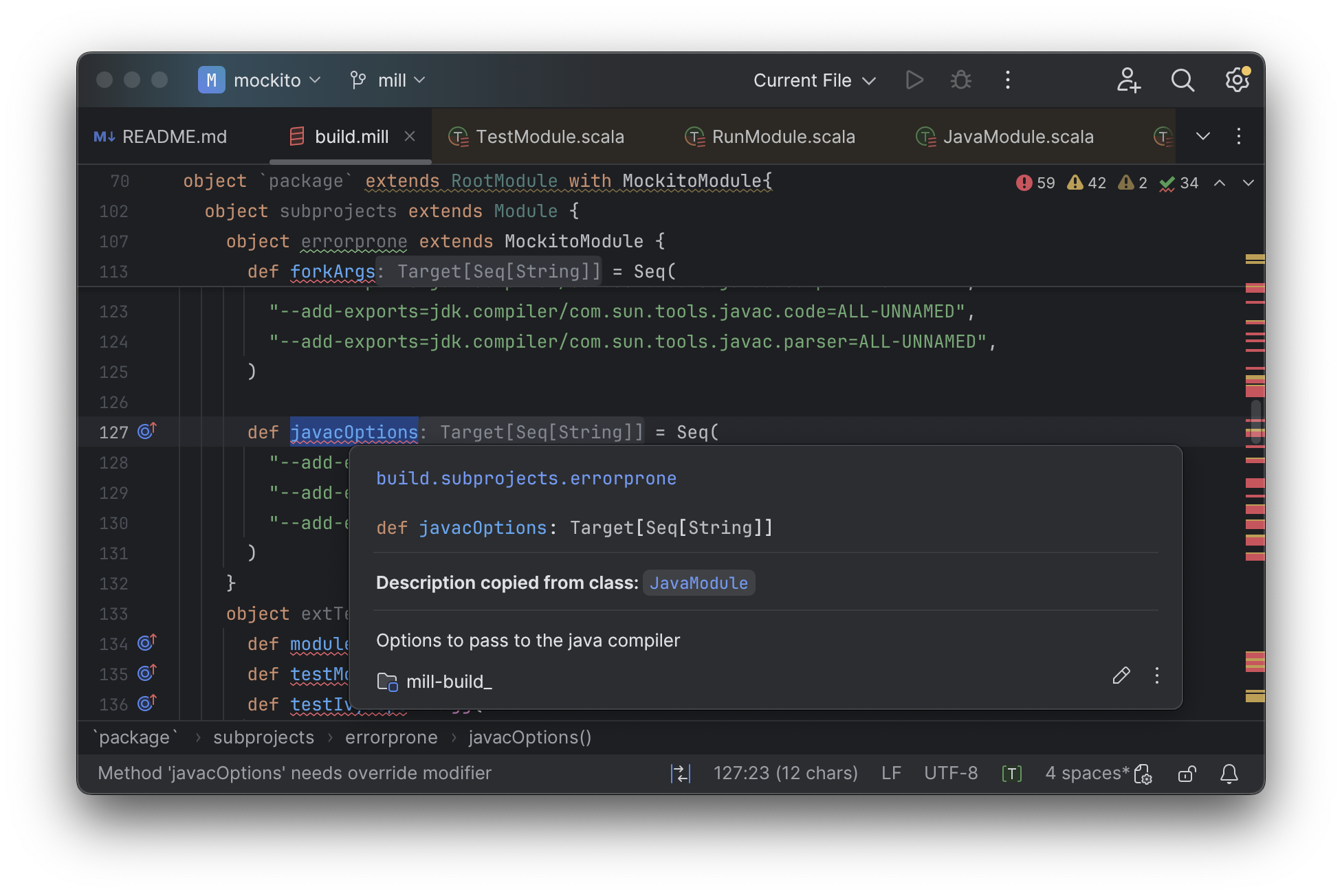
Apart from static typing, the way Mill builds are structured also helps the IDE: Mill
code actually performs your build, rather than configuring some opaque build engine.
While that sounds academic, one concrete consequence is that IntelliJ is able to take
your def javacOptions override and
find the original definitions that were overridden, and show you where they are defined:
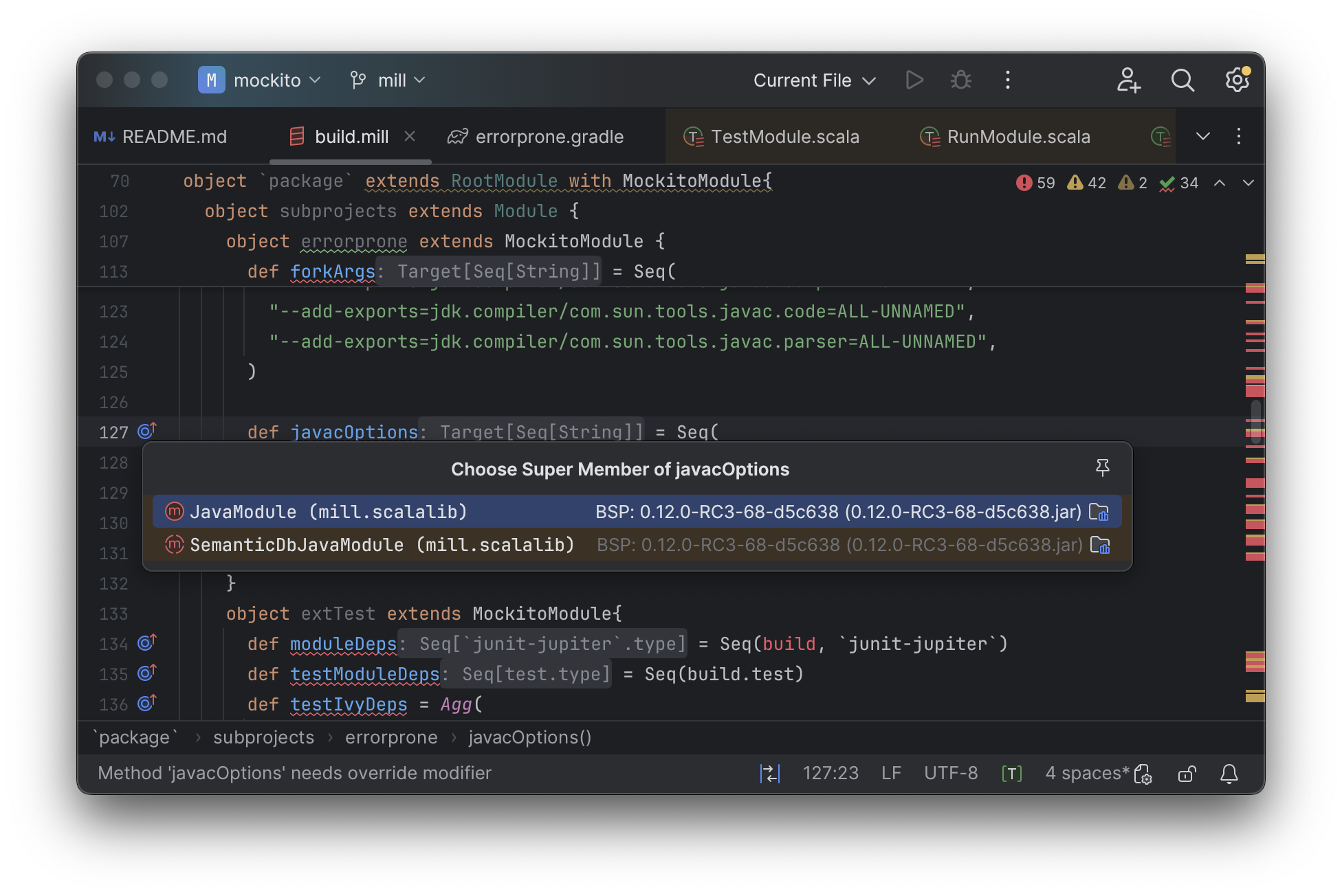
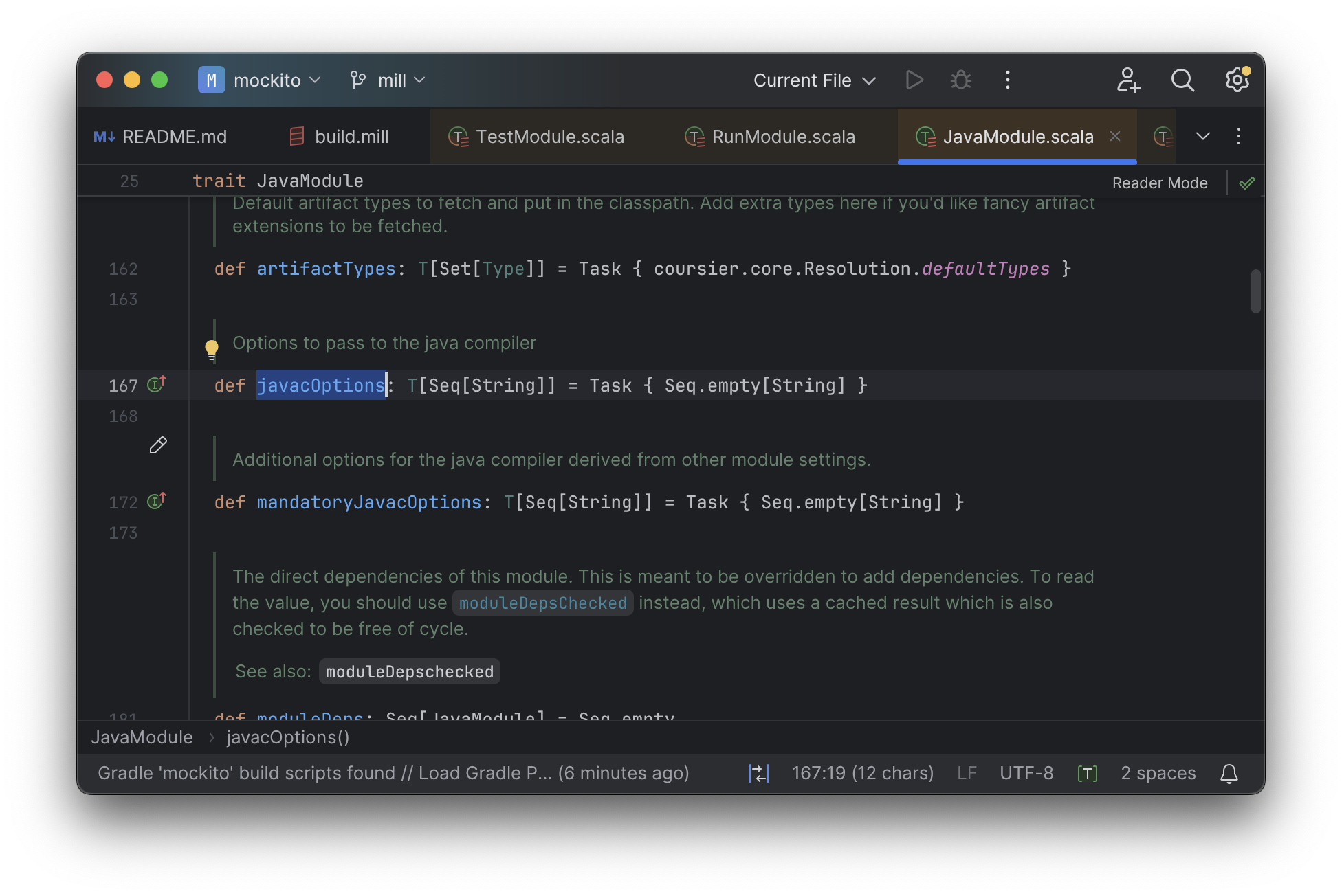
Furthermore, because task dependencies in Mill are just normal method calls, IntelliJ is
able to find usages, showing you where the task is used. Below, we can see the method
call in the def compile task, which uses javacOptions() along with a number of other tasks:

From there, if you are curious about any of the other tasks used alongside javacOptions, it’s
easy for you to pull up their documentation, jump to their
definition, or find their usages. For example we can pull up the docs of
compileClasspath() below:

Or we can use find usages on def compile to see where it is used, both in this build
and upstream in the Mill libraries:

Unlike most other build tools, Mill builds are extremely easy to explore interactively in your IDE. If you do not know what something does, it’s documentation, definition, or usages is always one click away in IntelliJ or VSCode. That’s not to say Mill builds aren’t complex - as we saw above, compilation has to deal with upstream outputs, classpaths, flags, reporters, and so on - but at least in Mill your IDE can help you explore, understand and manage the complexity in a way that no other build tool supports.
Note that the IDE experience that Mill provides should already be very familiar to anyone writing Java, Kotlin, or Scala:
-
of course, you can find the overridden definitions!
-
of course, you can pull up the documentation in a click!
-
of course, you can navigate around the codebase with your IDE, up and down the call graph, to see who calls who!
What Mill provides isn’t rocket science, but rather it is just about taking your existing experience and existing IDE tooling working with application codebases, and lets you use it to manage your build system as well.
Mill IDE support isn’t perfect - you may have noticed the spurious red squigglies above - but it’s much better than what you get with Gradle.
Conclusion
Both the Mill and Gradle builds we discussed in this case study do the same thing: they compile Java code and run tests. Sometimes they perform additional configuration, tweaking JVM arguments or doing ad-hoc classpath mangling.
In general, building projects with Mill is significantly faster than Gradle, but the gap is not as big as when comparing Mill v.s. Maven. Mill builds do all the same things as gradle builds, and need to manage the same kind of complexity. But where Mill shines over Gradle is just the understandability of the build: while Gradle is famously confusing and opaque, Mill’s great IDE support allows the user to explore and understand their build as easily as any application codebase, and its fool-proof approach to extensibility means non-experts can confidently modify or add to their build system without worrying about getting it wrong.
Again, the Mill build used in this comparison is for demonstration purposes, and more work would be necessary to make the Mill build production ready: publishing configuration, code coverage integration, and so on. Furthermore, Mill is definitely not perfect, and it is a work in progress to improve the user experience and iron out bugs. However, hopefully this comparison demonstrates the potential value, and convinces you to give it a try!